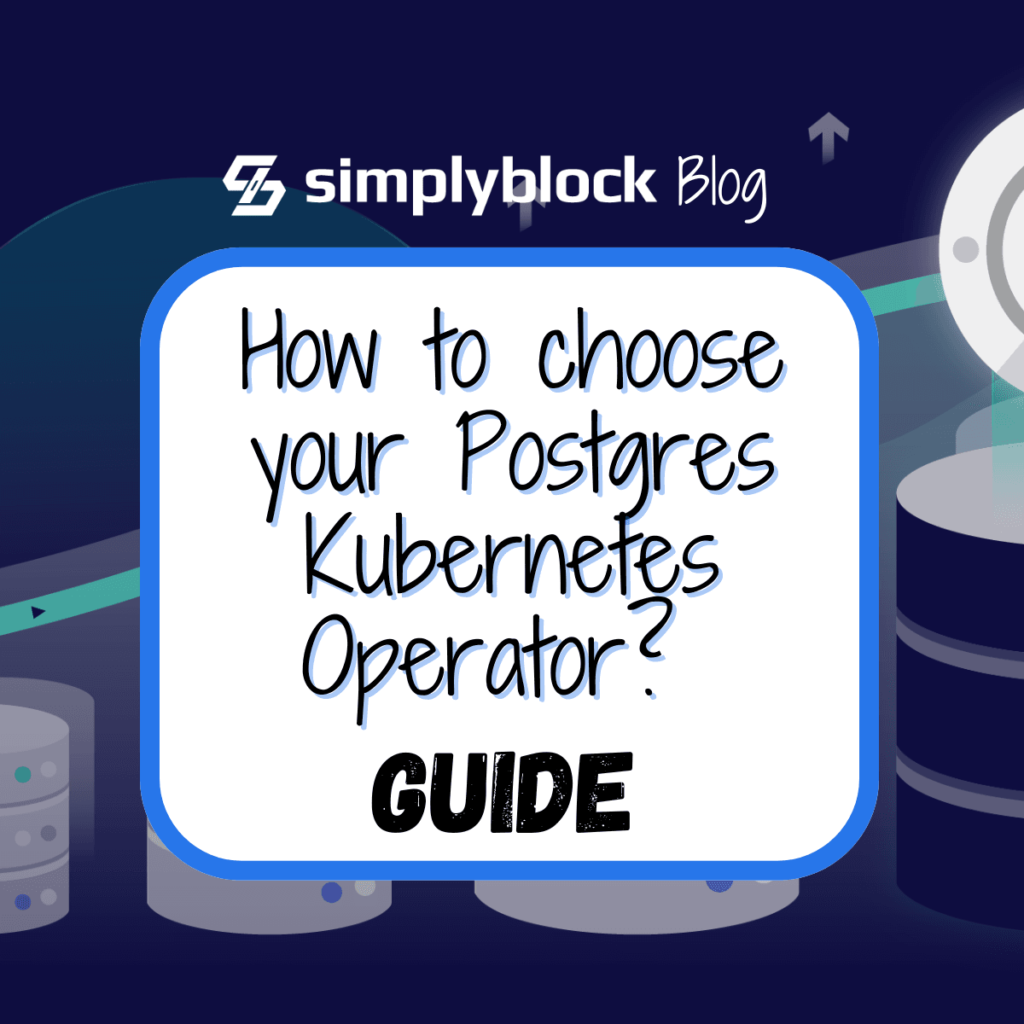
A Postgres Operator for Kubernetes eases the management of PostgreSQL clusters inside the Kubernetes (k8s) environment. It watches changes (additions, updates, deletes) of PostgreSQL related CRD (custom resource definitions) and applies changes to the running clusters accordingly.
Therefore, a Postgres Operator is a critical component of the database setup. In addition to the “simply” management of the Postgres cluster, it often also provides additional integration with external tools like pgpool II or pgbouncer (for connection pooling), pgbackrest or Barman (for backup and restore), as well as Postgres extension management.
Critical components should be chosen wisely. Oftentimes, it’s hard to exchange one tool for another later on. Additionally, depending on your requirements, you may need a tool with commercial support available, while others prefer the vast open source ecosystem. If both, even better.
But how do you choose your Postgres Operator of choice? Let’s start with a quick introduction of the most common options.
Stolon
Stolon is one of the oldest operators available. Originally released in November 2015 it even predates the term Kubernetes Operator .
The project is well known and has over 4.5k stars on GitHub. However the age shows. Many features aren’t cloud-native, it doesn’t support CRDs (custom resource definition), hence configuration isn’t according to Kubernetes. All changes are handled through a command line tool. Apart from that, the last release 0.17.0 is from September 2021, and there isn’t really any new activity on the repository. You can read that as “extremely stable” or “almost abandoned”. I guess both views on the matter are correct. Anyhow, from my point of view, the lack of activity is concerning for a tool that’s potentially being used for 5-10 years, especially in a fast-paced world like the cloud-native one.
Personally, I don’t recommend using it for new setups. I still wanted to mention it though since it deserves it. It did and does a great job for many people. Still, I left it out of the comparison table further below.
CloudNativePG
CloudNativePG is the new kid on the block, or so you might think. Its official first commit happened in March 2022. However, CloudNativePG was originally developed and sponsored by EDB (EnterpriseDB), one of the oldest companies built around PostgreSQL.
As the name suggests, CloudNativePG is designed to bring the full cloud-native feeling across. Everything is defined and configured using CRDs. No matter if you need to create a new Postgres cluster, want to define backup schedules, configure automatic failover, or scale up and down. It’s all there. Fully integrated into your typical Kubernetes way of doing things. Including a plugin for kubectl.
On GitHub , CloudNativePG skyrocketed in terms of stargazers and collected over 3.6k stars over the course of its lifetime. And while it’s not officially a CNCF (Cloud Native Computing Foundation) project, the CNCF stands pretty strongly behind it. And not to forget, the feature set is on par with older projects. No need to hide here.
All in all, CloudNativePG is a strong choice for a new setup. Fully in line with your Kubernetes workflows, feature rich, and a strong and active community.
Editor’s note: Btw, we had Jimmy Angelakos as a guest on the Cloud Commute podcast , and he talks about CloudNativePG. You should listen in.
Crunchy Postgres Operator (PGO)
PGO, or the Postgres Operator from Crunchy Data , has been around since March 2017 and is a very beloved choice by a good chunk of people. On GitHub, PGO has over 3.7k stars, an active community, quick response times to issues, and overall a pretty stable timeline activity.
Postgres resources are defined and managed through CRDs, as are Postgres users. Likewise, PGO provides integration with a vast tooling ecosystem, such as patroni (for automatic failover), pgbackrest (for backup management), pgbouncer (connection pooling), and more.
A good number of common extensions are provided out of the box, however, adding additional extensions is a little bit more complicated.
Overall, Crunchy PGO is a solid, production-proven option, also into the future. While not as fresh and hip as CloudNativePG anymore, it checks all the necessary marks, and it does so for many people for many years.
OnGres StackGres
StackGres by OnGres is also fairly new and tries to do a few things differently. While all resources can be managed through CRDs, they can also be managed through a CLI, and even a web interface. Up to the point that you can create a resource through a CRD, change a small property through the CLI, and scale the Postgres cluster using the webui. All management interfaces are completely interchangeable.
Same goes for extension management. StackGres has the biggest amount of supported Postgres extensions available, and it’s hard to find an extension which isn’t supported out of the box.
In terms of tooling integration, StackGres supports all the necessary tools to build a highly available, fault tolerant, automatically backed up and restored, scalable cluster.
In comparison to some of the other operators I really like the independent CRD types, giving a better overview of a specific resource instead of bundling all of the complexity of the Postgres and tooling ecosystem configuration in one major CRD with hundreds and thousands of lines of code.
StackGres is my personal favorite, even though it only accumulated around 900 starts on GitHub so far.
While still young, the team behind it is a group of veteran PostgreSQL folks. They just know what they do. If you prefer a bit of a bigger community, and less of a company driven project, you’ll be better off with CloudNativePG, but apart from that, StackGres is the way to go.
Editor’s note: We had Álvaro Hernández, the founder and CEO of OnGres , in our Cloud Commute podcast, talking about StackGres and why you should use it. Don’t miss the first hand information.
AppsCode KubeDB
KubeDB by AppsCode is different. In development since 2017, it’s well known in the community, but an all-in commercial product. That said, commercial support is great and loved.
Additionally, KubeDB isn’t just PostgreSQL. It supports Elasticsearch, MongoDB, Redis, Memcache, MySQL, and more. It’s a real database-in-a-box deployment solution.
All boxes are checked for KubeDB and there isn’t much to say about it other than, if you need a commercially supported operator for Postgres, look no further than KubeDB.
Zalando Postgres Operator
Last but not least, the Postgres Operator from Zalando . Yes, that Zalando, the one that sells shoes and clothes.
Zalando is a big Postgres user and started early with the cloud-native journey. Their operator has been around since 2017 and has a sizable fanbase. On GitHub the operator managed to collect over 4k stars, has a very active community, a stable release cadence, and is a great choice.
In terms of integrations with the tooling ecosystem, it provides less flexibility and is slightly opinionated towards how things are done. It was developed for Zalando’s own infrastructure first and foremost though.
Anyhow, the Zalando operator has been and still is a great choice. I actually used it myself for my previous startup and it just worked.
Which Postgres Kubernetes Operator should I Use?
You already know the answer, it depends. I know we all hate that answer, but it is true. As hinted at in the beginning, if you need commercial support certain options are already out of the scope.
It also depends if you already have another Postgres cluster with an operator running. If it works, is there really a reason to change it or introduce another one for the new cluster?
Anyhow, below is a quick comparison table of features and supported versions that I think are important.
| CloudNativePG | Crunchy Postgres for Kubernetes | OnGres StackGres | KubeDB | Zalando Postgres Operator | |
|---|---|---|---|---|---|
| Tool version | 1.23.1 | 5.5.2 | 1.10.0 | v2024.4.27 | 1.12.0 |
| Release date | 2024-04-30 | 2024-05-23 | 2024-04-29 | 2024-04-30 | 2024-05-31 |
| License | Apache 2 | Apache 2 | AGPL3 | Commercial | MIT |
| Commercial support | ✔ | ✔ | ✔ | ✔ | ✘ |
Supported PostgreSQL Features
| CloudNativePG | Crunchy Postgres for Kubernetes | OnGres StackGres | KubeDB | Zalando Postgres Operator | |
|---|---|---|---|---|---|
| Supported versions | 12, 13, 14, 15, 16 | 11, 12, 13, 14, 15, 16 | 12, 13, 14, 15, 16 | 9.6, 10, 11, 12, 13, 14 | 11, 12, 13, 14, 15, 16 |
| Postgres Clusters | ✔ | ✔ | ✔ | ✔ | ✔ |
| Streaming replication | ✔ | ✔ | ✔ | ✔ | ✔ |
| Supports Extensions | ✔ | ✔ | ✔ | ✔ | ✔ |
High Availability and Backup Features
| CloudNativePG | Crunchy Postgres for Kubernetes | OnGres StackGres | KubeDB | Zalando Postgres Operator | |
|---|---|---|---|---|---|
| Hot Standby | ✔ | ✔ | ✔ | ✔ | ✔ |
| Warm Standby | ✔ | ✔ | ✔ | ✔ | ✔ |
| Automatic Failover | ✔ | ✔ | ✔ | ✔ | ✔ |
| Continuous Archiving | ✔ | ✔ | ✔ | ✔ | ✔ |
| Restore from WAL archive | ✔ | ✔ | ✔ | ✔ | ✔ |
| Supports PITR | ✔ | ✔ | ✔ | ✔ | ✔ |
| Manual backups | ✔ | ✔ | ✔ | ✔ | ✔ |
| Scheduled backups | ✔ | ✔ | ✔ | ✔ | ✔ |
Kubernetes Specific Features
| CloudNativePG | Crunchy Postgres for Kubernetes | OnGres StackGres | KubeDB | Zalando Postgres Operator | |
|---|---|---|---|---|---|
| Backups via Kubernetes | ✔ | ✘ | ✔ | ✔ | ✘ |
| Custom resources | ✔ | ✔ | ✔ | ✔ | ✔ |
| Uses default PG images | ✘ | ✔ | ✔ | ✘ | ✘ |
| CLI access | ✔ | ✔ | ✔ | ✔ | ✘ |
| WebUI | ✘ | ✘ | ✔ | ✔ | ✘ |
| Tolerations | ✔ | ✔ | ✔ | ✔ | ✔ |
| Node affinity | ✔ | ✔ | ✔ | ✔ | ✔ |
How to choose your Postgres Operator?
The graph below shows the GitHub stars of the above Postgres Operators. What we see is a clear domination of Stolon, PGO, and Zalando’s PG Operator, with CloudNativePG rushing in from behind. StackGres, while around longer than CloudNativePG doesn’t have the community backing behind it, yet. But GitHub stars aren’t everything.
All of the above tools are great options, with the exception of Stolon, which isn’t a bad tool, but I’m concerned about the lack of activity. Make of it what you like.
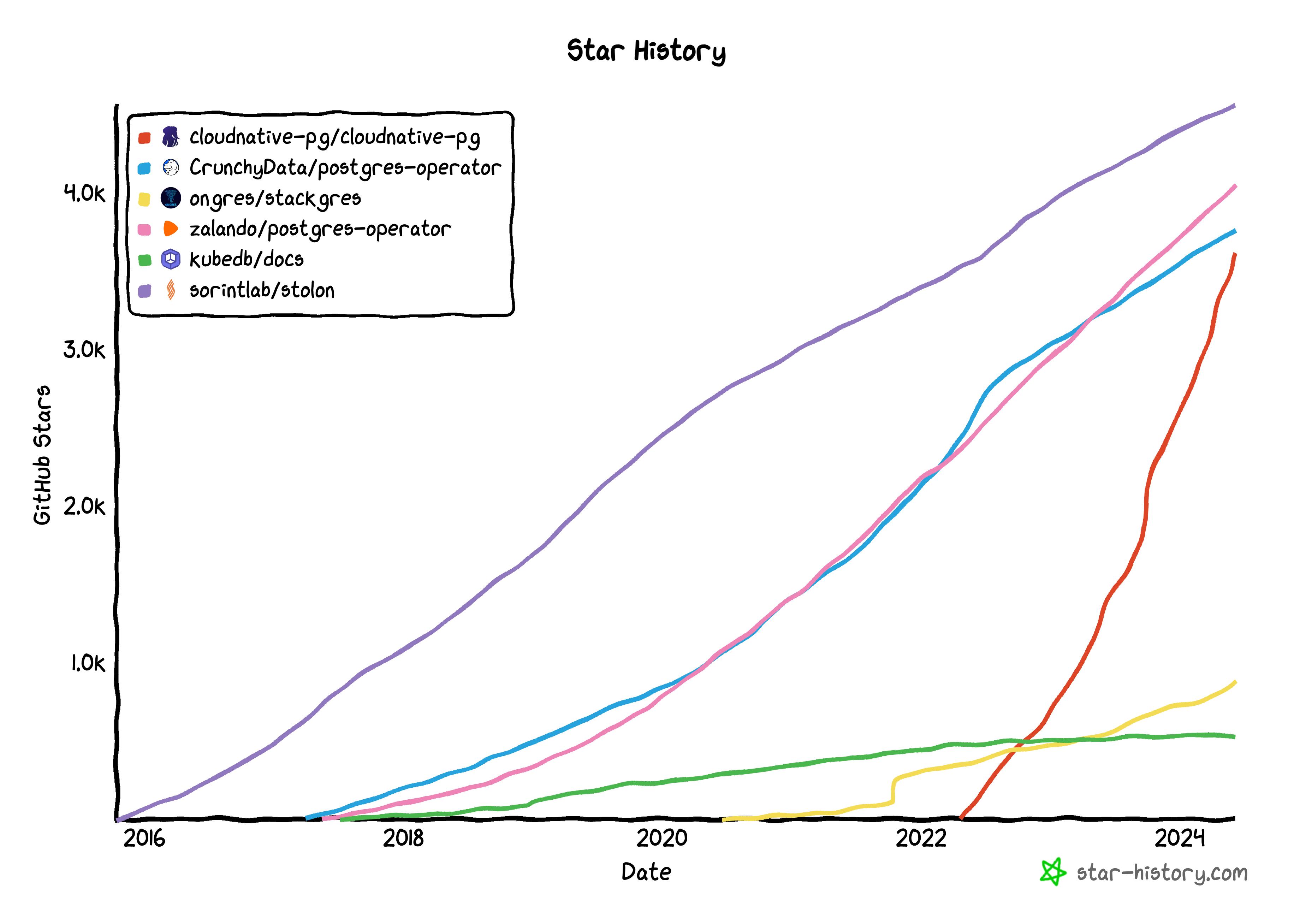
Before closing, I want to quickly give some honorable mentions to two further tools.
Percona has an operator for PostgreSQL, but the community is very small right now. Let’s see if they manage to bring it on par with the other tools. If you use other Percona tools, it’s certainly worth giving it a look: Percona Operator for PostgreSQL .
The other one is the External PostgreSQL Server Operator by MoveToKube . It didn’t really fit the topic of this blog post as it’s less of a Postgres Operator but more of a database (in Postgres’ relational entity sense) and users management tool. Meaning, it uses CRDs to add, update, remove databases in external PG servers, as it does for Postgres users. Anyhow, this tool also works with services like Timescale Cloud, Amazon RDS, and many more. Worth mentioning and maybe you can make use of it in the future.
Topics
Share blog post
Tags
Amazon EKS, Azure Kubernetes Service, EKS, Elastic Kubernetes Service, GKE, Google Kubernetes Engine, K8s, Kubernetes, Kubernetes Operator, Postgres, Postgres Kubernetes Operator, Postgres Operator, PostgreSQL, PostgreSQL OperatorYou may also like:
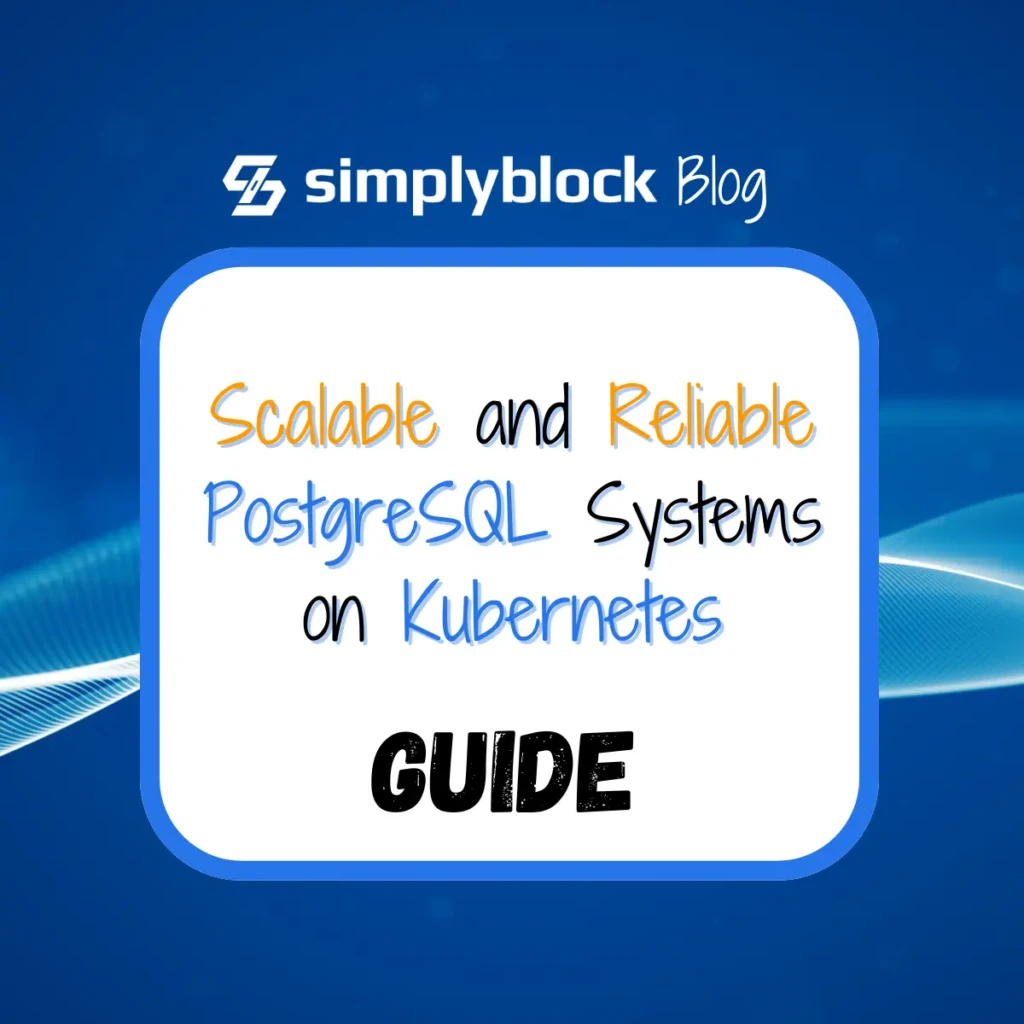
How to Build Scalable and Reliable PostgreSQL Systems on Kubernetes
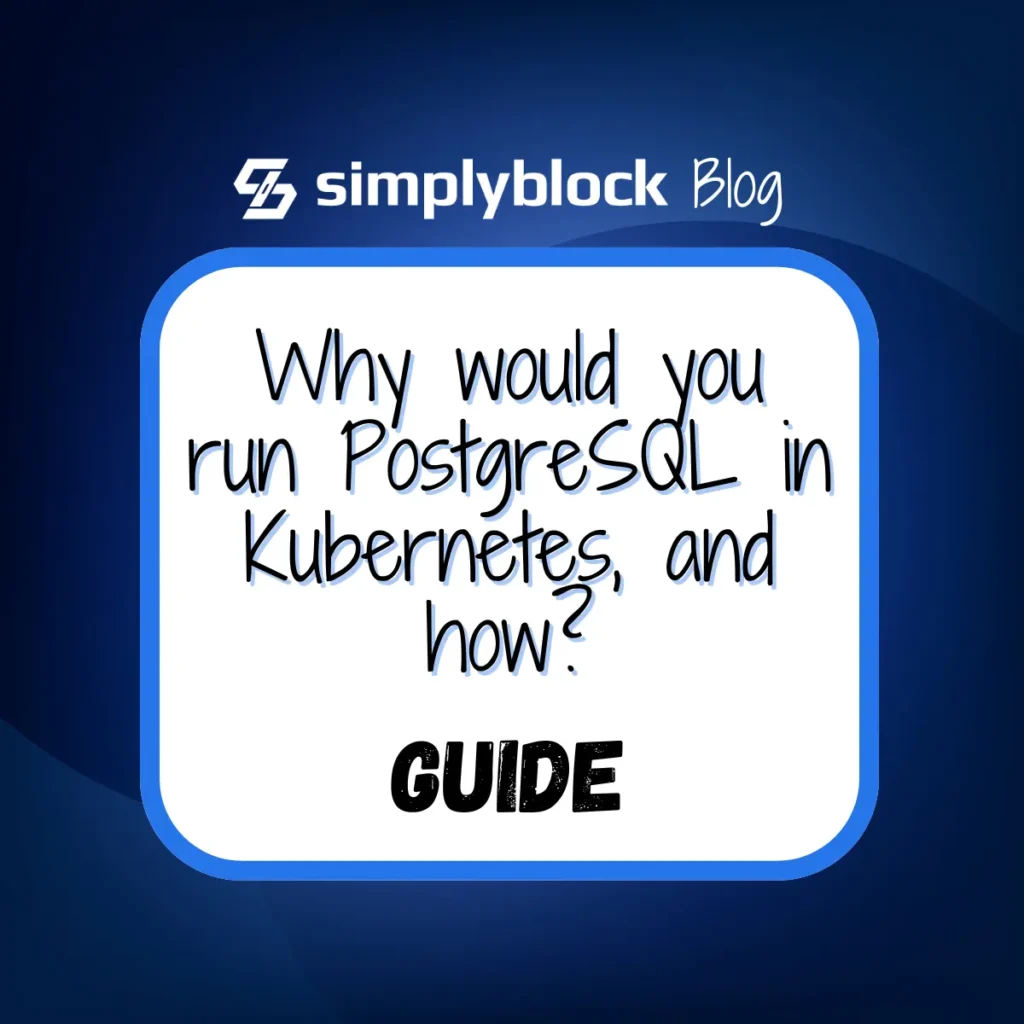
Why would you run PostgreSQL in Kubernetes, and how?
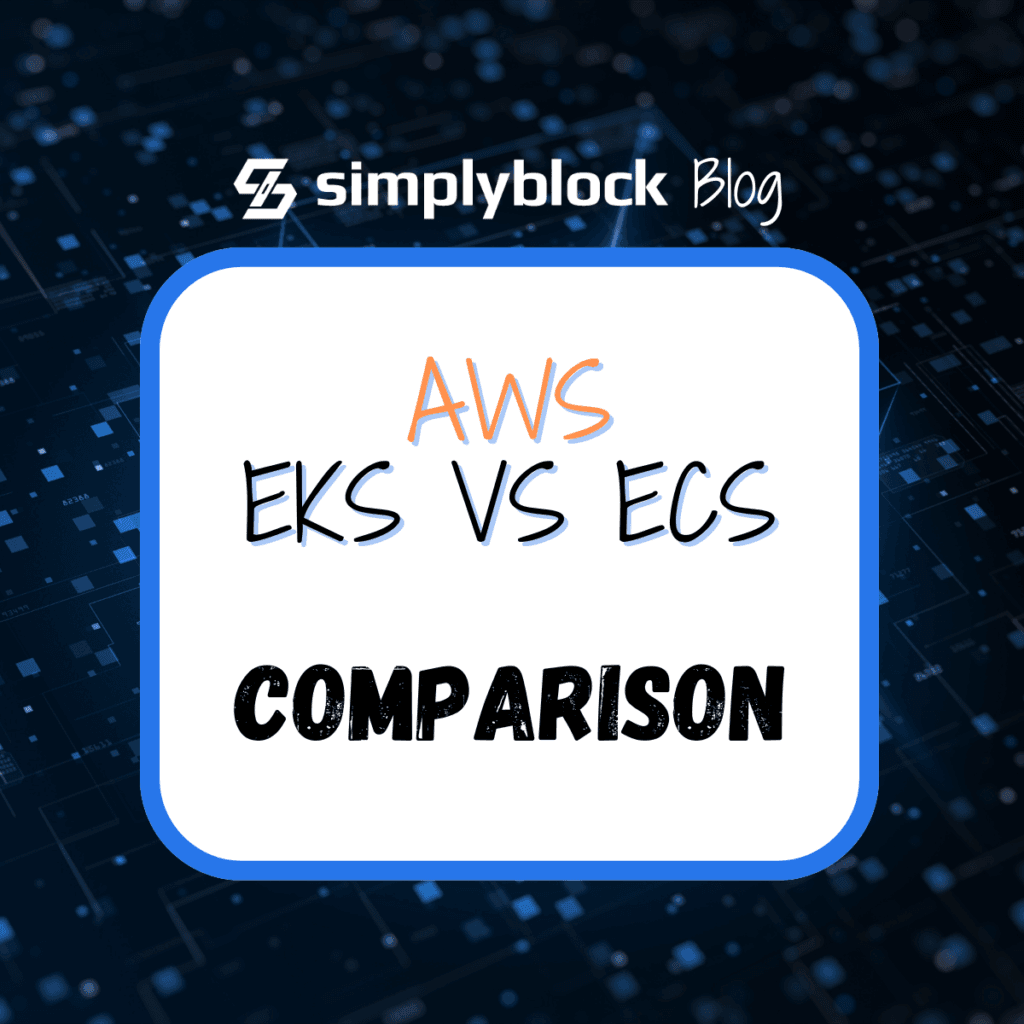
Amazon EKS vs. ECS: Understanding the Differences and Choosing the Right Service
